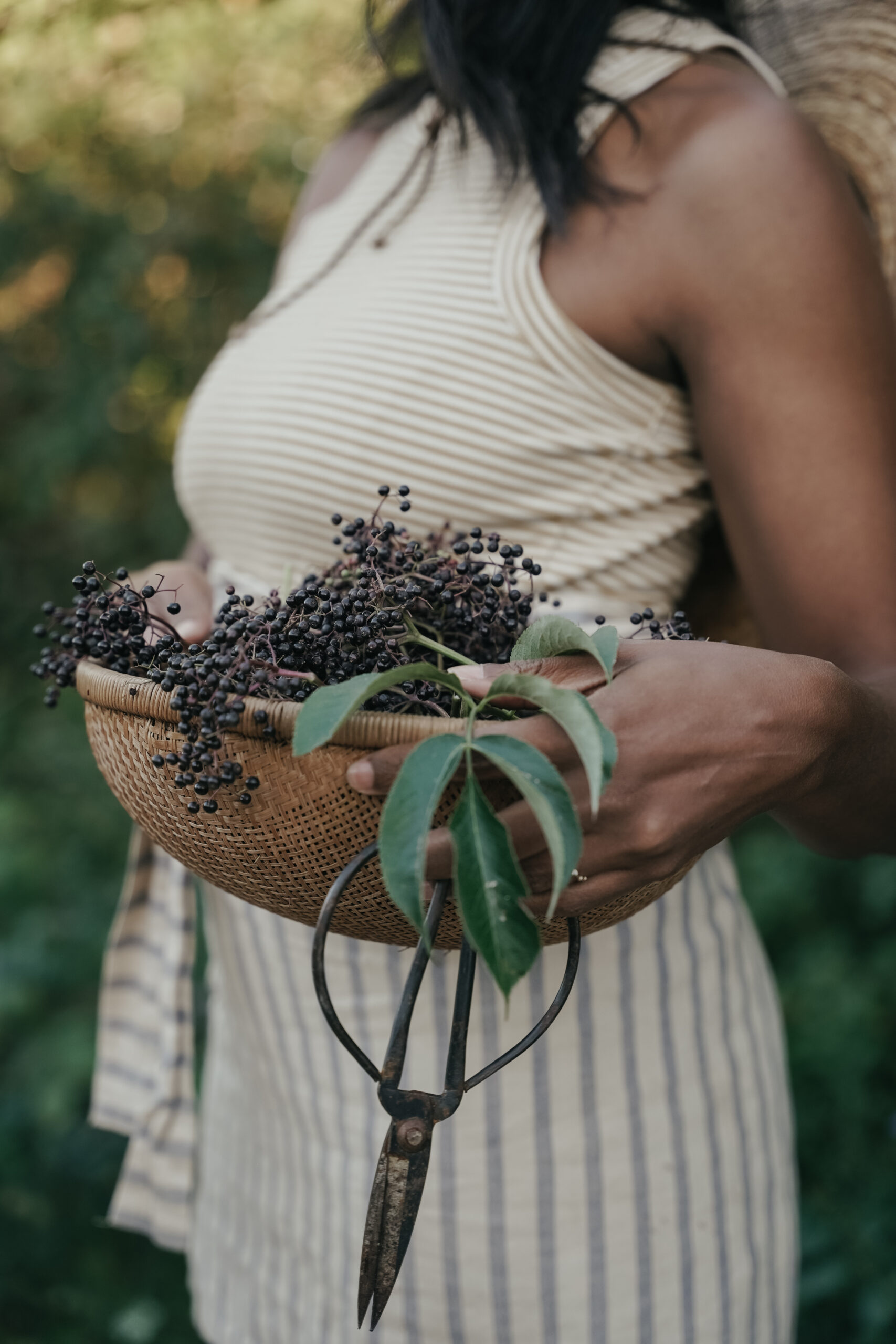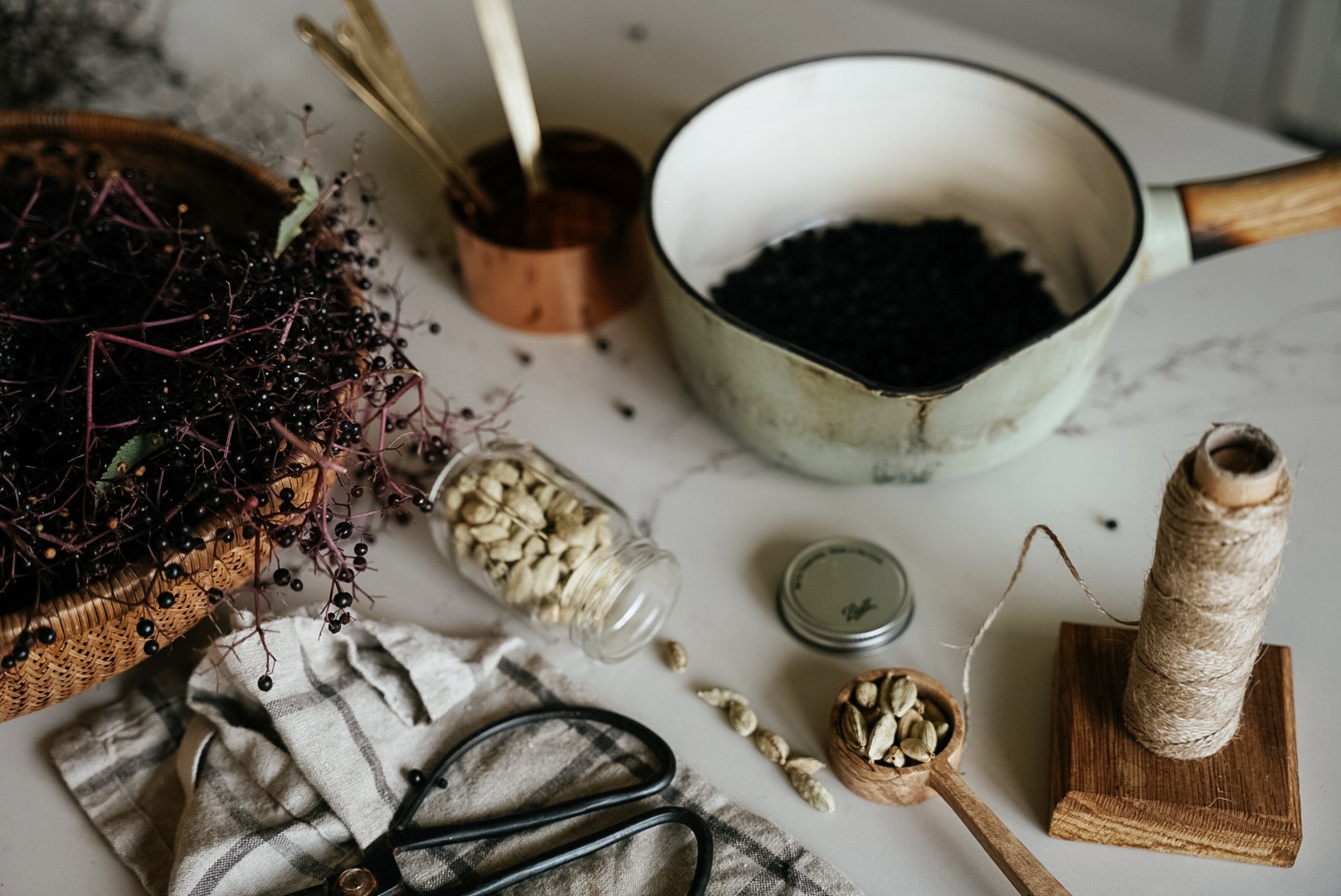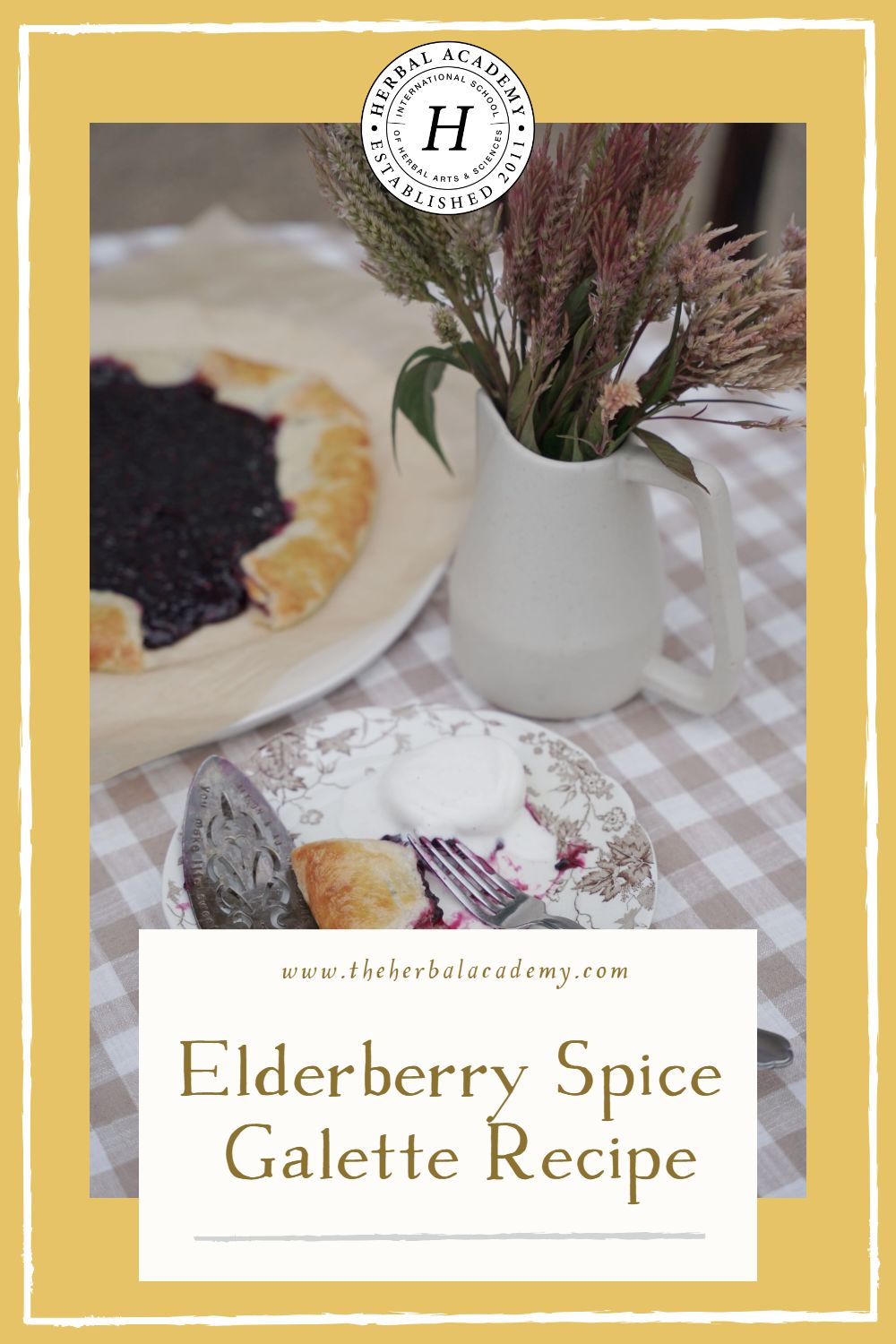
Elderberry Spice Galette Recipe
As the season shifts from high summer to early autumn, we begin to prepare for what lies ahead. Connecting back with the rhythms of the earth helps us to honor our inner worlds. The life cycle of plants, reflected in their appearance, marks the shifts in time and is an invitation into ritual to honor that passage. Just as the moon transitions from waxing to waning, as the expansion of summer wanes, autumn signals a contraction and inward movement. As we begin to prepare our homes for winter, we collect the harvests of summer, and our children go back to school. We can support our bodies through this transition time with herbal allies such as the elderberries featured in this delicious Elderberry Spice Galette recipe!
The elderflowers of midsummer are shifting into berries as they ripen from green to dark burgundy on their stem. Elderberry (Sambucus nigra, S. canadensis) was one of the first plant allies I used as a young mother. A dear friend of mine, Amelia, told me how she ordered the dried berries online to make a syrup to take during the fall and winter. To me, elderberry is about nurturing, caring, and tending to ourselves and those we love.
Now instead of ordering dried elderberries, I love to harvest them fresh in August and September. Not only do they line our driveway and prairie edge, I see them all over our area here in the Driftless region of Wisconsin. As I dove more deeply into methods of preserving our harvest, I realized elderberries were used in folk traditions in a variety of ways, such as jams, jellies, wine, cordials, and baked goods. Adding warming and stimulating autumn spices not only enhances taste and potency but allows us to connect to the rejuvenating potential of our food.

Elder (Sambucus nigra, S. canadensis)
Elder is becoming a household name with a variety of syrups on the market, and is known for its immune-boosting properties and support for the common cold. Elder is pungent, slightly sweet, and slightly astringent. Its berries (flowers, too!) are exceptional allies during colds, flu, and respiratory infections due to their diaphoretic and antiviral actions, particularly at the initial signs of cold or flu. Elderberry contains various nutrients including vitamins A and C, dietary fiber and minerals, such as iron and potassium, and antioxidant potential in flavonoids which protect the cardiovascular system like many other berries (Johnson et al., 2010) (Salmón, 2020).
Elderberries can be found growing fresh along the woods. When harvesting fresh rather than using dried berries, make sure berries are fully ripe before harvesting, opting for the dark, full berries over reddish ones. Harvest the full stalk and remove the berries from as much of the stem as possible. When harvesting and using fresh berries in preparations, you can determine their readiness by submerging them in a bowl of water; under-ripe berries (usually green and reddish) will surface and should be discarded, as their consumption can lead to gastrointestinal discomfort (Heckels et al., 2019).

Spicing Up Your Elderberry Galette
Spices from your kitchen pantry are just as potent as herbs foraged or from your garden. Spices added to food provide depth of flavor as well as herbal support.
Cardamom (Elettaria cardamomum) Seed
I love the addition of cardamom into my cooking and baking. Cardamom is widely used in food and herbal applications. According to Ayurveda, cardamom stimulates digestion and reduces vata and kapha doshas, and when used in excess, it can increase pitta, though this is unlikely to happen if used in moderation. It also increases the absorption and assimilation of nutrients in the body, increases digestive fire, and moves stagnation (Frawley & Lad, 1988). Cardamom enhances and balances out many digestive ailments such as gas, bloating, colic, pain, and indigestion. Cardamom is antimicrobial and antiviral (Frawley & Lad, 1988).
Cinnamon (Cinnamomum spp.) Bark
Cinnamon (Cinnamomum spp.) is a commonly employed spice in baking and curries and a cornerstone in Middle Eastern cuisine, used for its simultaneously sweet and pungent flavor. Cinnamon’s sweet, almost spicy, stimulating, and aromatic nature also has its own supportive properties for health. Various studies are being released supporting cinnamon’s beneficial effects on blood glucose and aiding in type 2 diabetes (Lu et al., 2012). Cinnamon has been used for thousands of years as a preservative; it is antimicrobial, antifungal, antiviral, and an antioxidant.

Trade the pumpkin spice for elderberry spice in this mouthwatering recipe! While elderberries are a common staple used in syrups, tinctures, and decoctions, as in our Calendula Elderberry Cold & Flu Elixir, there is a long tradition of using elderberries in the kitchen. For the dinner table this autumn, may we suggest…a tantalizing Elderberry Spice Galette!
1 pie crust *For dried berries, soak 2 ½ cups in 4 cups of water for 30 minutes; drain liquid.
Elderberry Spice Galette
3 cups elderberries* (Sambucus nigra or S. canadensis) (you can also add blueberries to meet 3 cups)
1 1/2 cups sugar
4 tablespoons cornstarch or tapioca starch
1/4 cup cold water
1 tablespoon lemon juice and zest
1 teaspoon vanilla extract
1 teaspoon cinnamon (Cinnamomum spp.) bark, ground
1/2 tsp cardamom (Elettaria cardamomum) seed, ground
Enjoy with vanilla ice cream! Another variation on this recipe that is delicious is adding another autumn treat—pears! Sliced pears mixed with elderberries make a delicious balance.
In Closing,
Elderberries are a wonderful way to support your immune system, especially during the seasonal shift into autumn. Herbal preparations such as syrups, tinctures, and teas are useful, but we can also find creative and inventive ways to bring herbal support into our daily rhythms and make it a delicious treat for the family to enjoy.

REFERENCES
Frawley, D., & Lad, V. (1988). The yoga of herbs: An Ayurvedic guide to herbal medicine, 2nd ed. Lotus Press.
Heckels, F., Lawton, K., & Benfield, B. (2019). The sensory herbal handbook: Connect with the medicinal power of your local plants. Watkins Publishing.
Johnson, R., Foster, S., Low Dog, T., & Kiefer, D. (2010). Guide to medicinal herbs. National Geographic Society.
Lu, T., Sheng, H., Wu, J., Cheng, Y., Zhu, J., & Chen, Y. (2012) Cinnamon extract improves fasting blood glucose and glycosylated hemoglobin level in Chinese patients with type 2 diabetes [Abstract]. Nutritional Research, 32(6), 408-412, doi: 10.1016/j.nutres.05.003
Salmón, E. (2020). Iwígara. Timber Press, Inc.








